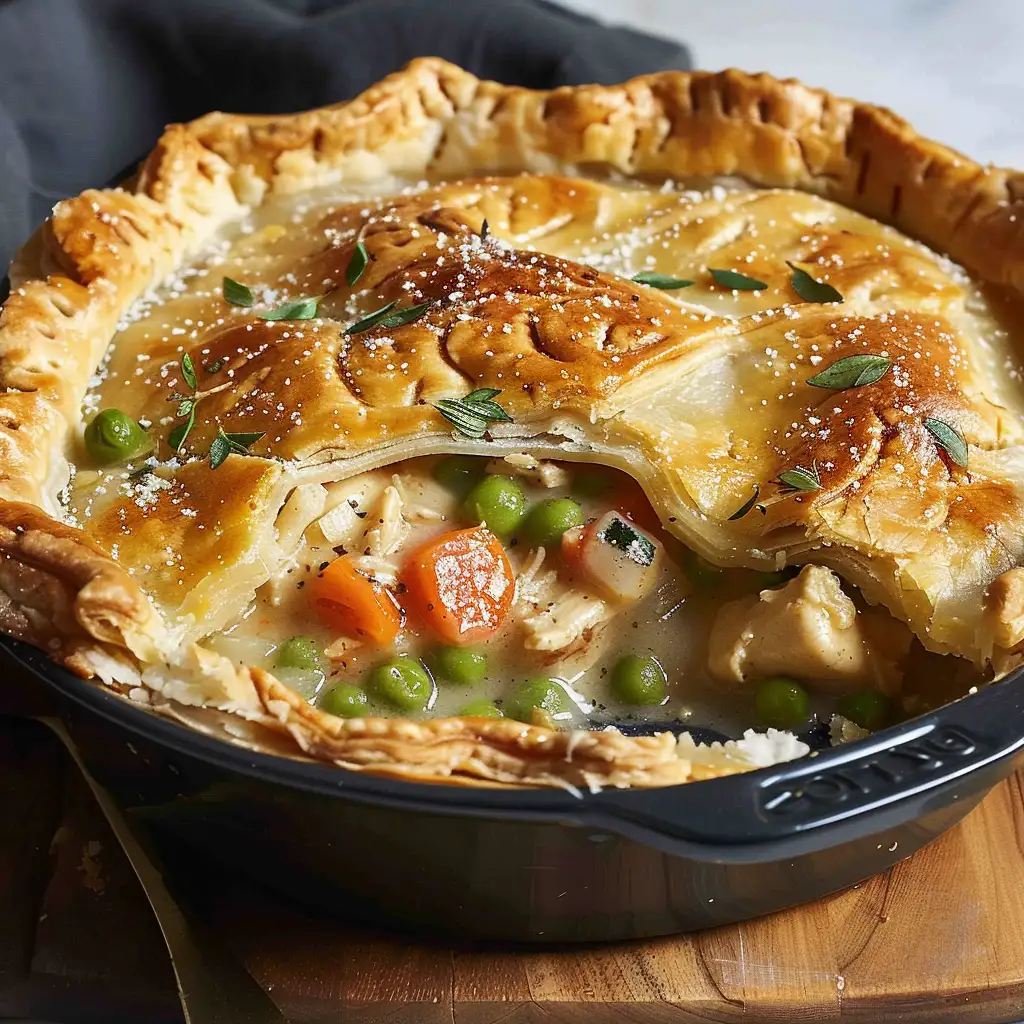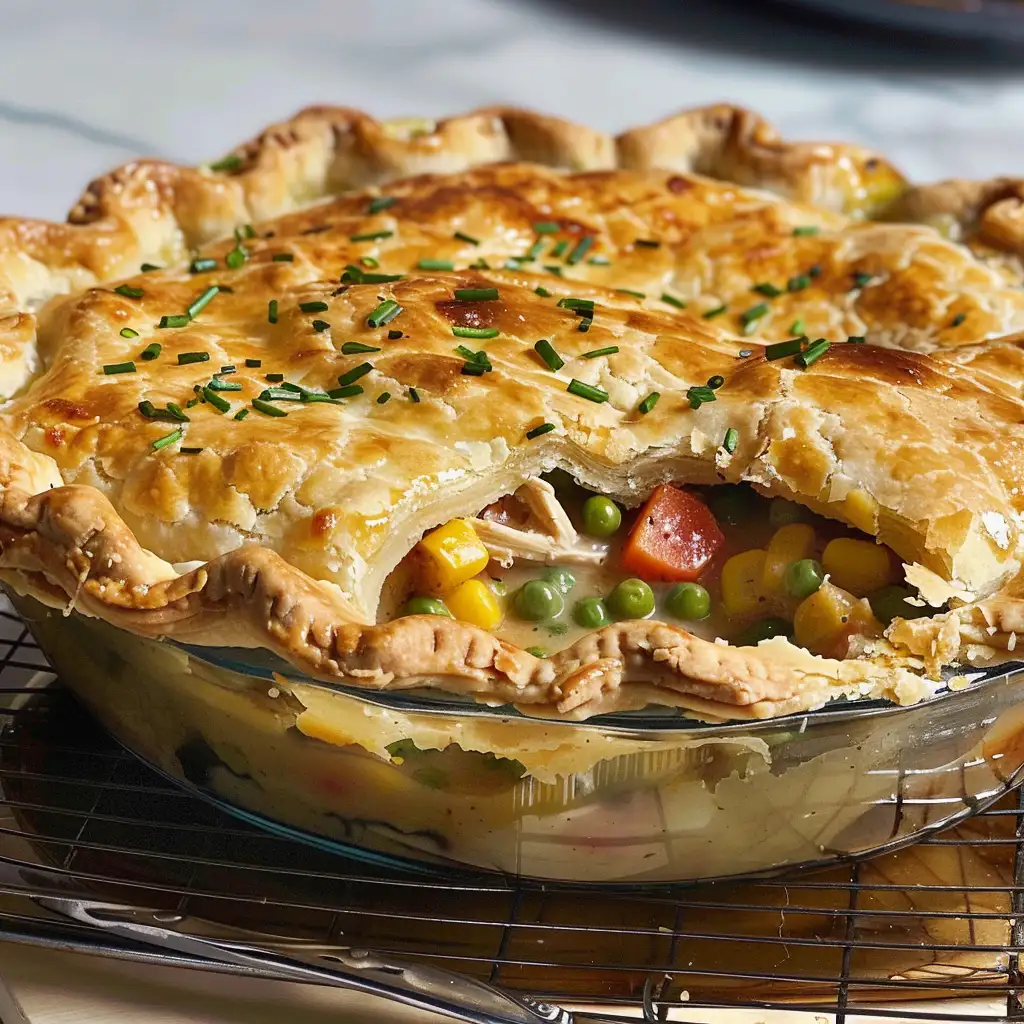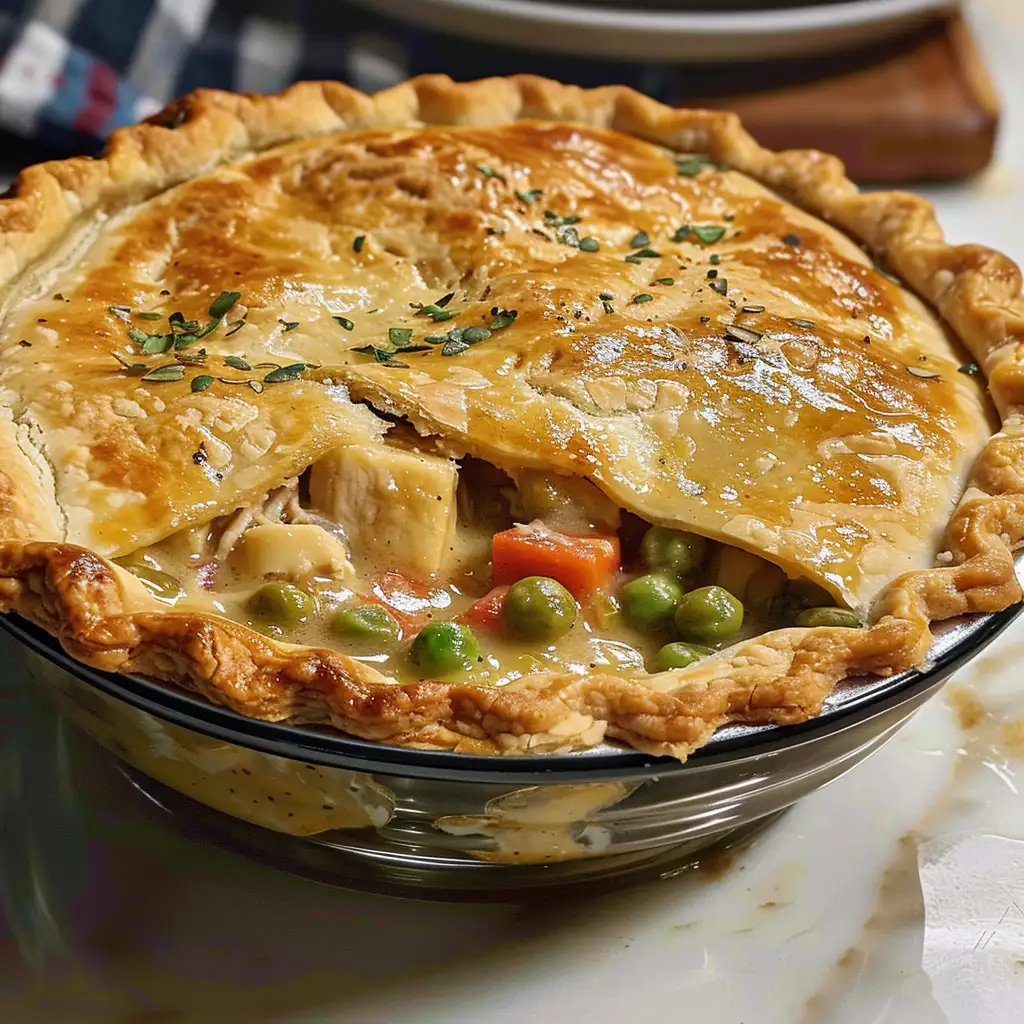Introduction to Chicken Pot Pie
Chicken Pot Pie stands as a quintessential example of comfort food, deeply rooted in culinary history. Originating from the classic pot pie concept, this dish has evolved significantly over the centuries. Initially, pot pies were a means to utilize leftover ingredients, encased in a pot with a doughy crust. The American Chicken Pot Pie emerged as a variation, incorporating chicken, vegetables, and a creamy sauce, all baked under a crust of pastry. This evolution reflects the dish’s adaptability and its steadfast presence in comfort cuisine, transitioning from a practical meal for early settlers to a beloved classic in modern American households.
The Basics of Chicken Pot Pie
Ingredients Overview
The essence of Chicken Pot Pie lies in its simplicity and the hearty combination of its components:
- Essential components: The core ingredients include chicken, a mix of vegetables (commonly carrots, peas, and celery), a savory broth, and a flaky crust enveloping the filling.
- Optional ingredients: For added depth, mushrooms, potatoes, or onions can be incorporated, alongside herbs like thyme or parsley to enhance flavor.
Understanding the balance of these elements is crucial in crafting a pot pie that’s both nourishing and flavorful, showcasing the dish’s versatility and appeal.
Making the Perfect Pie Crust
The crust is pivotal in differentiating a good Chicken Pot Pie from a great one. Choices between homemade and store-bought crusts can dictate the pie’s texture and flavor profile:
- Homemade vs. store-bought options: While homemade dough can offer a more authentic and tender crust, store-bought puff pastry is a convenient alternative that doesn’t compromise on flakiness.
- Tips for a flaky and tender crust: Incorporating cold butter into the flour, using ice water, and handling the dough minimally are key techniques for achieving the perfect crust.
For enthusiasts looking to delve deeper into the art of pie-making, exploring resources like Perfect Pie Crust Tips can provide additional insights and techniques to enhance your baking skills.

Crafting the Filling
Preparing Your Ingredients
A delicious Chicken Pot Pie starts with careful preparation of your ingredients. Here are some best practices:
- Chopping vegetables: Ensure vegetables are chopped uniformly for even cooking. Small dices work best for quick, thorough cooking.
- Preparing chicken: Opt for boneless, skinless chicken breasts or thighs, cut into bite-sized pieces. This ensures that the chicken cooks evenly and integrates well with the rest of the filling.
- Importance of seasoning: Season your chicken and vegetables well with salt and pepper before cooking. Don’t forget to taste your filling mixture as you cook, adjusting the seasoning as necessary to ensure a rich and balanced flavor profile.
Preparing your ingredients with care is the first step towards a pie filling that’s both flavorful and satisfying.
Building the Filling
Creating the filling involves a few key steps that layer flavors and textures:
- Sautéing vegetables: Start by cooking onions, carrots, and celery in a bit of butter until they’re soft but not browned. This base adds depth to your pie.
- Adding chicken: Add the seasoned chicken pieces, cooking until they’re just starting to brown. It’s crucial not to fully cook the chicken at this stage since it will continue cooking in the oven.
- Thickening with flour: Sprinkle flour over the cooked vegetables and chicken, stirring well to coat. The flour helps thicken the broth, creating a creamy filling.
- Balancing flavors: Add chicken broth and a dash of cream, bringing the mixture to a simmer. Incorporate herbs such as thyme or parsley for an aromatic lift. Adjust seasoning as needed.
This step-by-step process ensures your filling is rich, creamy, and bursting with flavor. For those looking to enhance their culinary skills, Roasted Vegetable Guide offers additional insights into preparing side dishes that complement your pot pie.
Assembling the Pie
The final assembly is where your Chicken Pot Pie comes together:
- Layering the filling and crust: Pour the cooled filling into your pie dish. For the bottom crust, you can use a pre-baked shell or layer raw dough directly under the filling for a more rustic pie.
- Techniques for a lattice top or a full crust: For a lattice top, weave strips of pie dough over the filling. For a full crust, simply lay a rolled-out piece of dough over the pie, pressing the edges to seal. Don’t forget to cut slits in the top crust to allow steam to escape during baking.
Assembling your pie with attention to the crust and filling ensures that each bite offers the perfect mix of flaky pastry and hearty, flavorful filling. The final product, a golden-brown crust encasing a warm, savory interior, symbolizes the heartwarming appeal of Chicken Pot Pie.

Cooking and Serving
Baking the Perfect Chicken Pot Pie
Achieving the perfect Chicken Pot Pie involves careful attention to oven temperature and placement:
- Preheat your oven to 375°F (190°C). This ensures the pie starts cooking at the right temperature for a golden crust.
- Place the pie on the lower-middle rack. This position allows the bottom crust to cook thoroughly without burning the top.
- To ensure a golden crust and thoroughly cooked filling, brush the top crust with an egg wash before baking. Bake until the crust is golden brown and the filling bubbles, approximately 45 minutes to 1 hour.
- Let the pie rest for 10 minutes before serving. This allows the filling to set, making it easier to slice.
Serving Suggestions
When it comes to serving Chicken Pot Pie, the right accompaniments can elevate the meal:
- Accompaniments: A simple green salad or roasted vegetables like Brussels sprouts or carrots complements the richness of the pie. Consider visiting Roasted Vegetable Guide for ideas on preparing vegetables.
- Presentation tips: Serve the pie directly from the dish for a rustic appeal. Use a sharp knife or pie server to ensure clean slices. Garnish with fresh herbs for a pop of color.
Storing and Reheating
Properly storing and reheating Chicken Pot Pie can maintain its flavor and texture:
- Refrigeration: Cool the pie completely before covering it with foil or plastic wrap. Refrigerate for up to 3 days.
- Freezing: Freeze slices or the whole pie in airtight containers. Thaw overnight in the refrigerator before reheating.
- Reheating: To preserve the crust’s texture, reheat in the oven at 350°F (175°C) until warm. For individual slices, a microwave can be used, but the crust may soften.
Following these steps ensures your Chicken Pot Pie remains a delightful comfort meal, whether served fresh or as a delicious leftover.

FAQs on Chicken Pot Pie
When it comes to Chicken Pot Pie, several common questions arise, reflecting the dish’s popularity and the desire to perfect it. Here are some frequently asked questions and their answers:
- Can Chicken Pot Pie be made in advance?
- Yes, you can prepare Chicken Pot Pie ahead of time. Assemble the pie and refrigerate or freeze it before baking. If frozen, thaw in the fridge before baking or adjust baking time accordingly.
- Is it possible to use leftover chicken?
- Absolutely. Leftover chicken or rotisserie chicken is perfect for pot pie, making the dish quicker to prepare. Ensure the chicken is properly seasoned to integrate well with the other flavors.
- Can Chicken Pot Pie be frozen?
- Chicken Pot Pie freezes beautifully. You can freeze it either before or after baking. Just make sure to wrap it tightly to prevent freezer burn and thaw it in the refrigerator before reheating.
- What are the best vegetables to use in Chicken Pot Pie?
- Classic vegetables include peas, carrots, and celery. However, you can get creative and use corn, potatoes, or green beans based on your preferences.
- How can I prevent the bottom crust from becoming soggy?
- Pre-baking the bottom crust (blind baking) for a few minutes, or adding a layer of egg wash before adding the filling, can help prevent sogginess.
For more in-depth advice on creating the perfect Chicken Pot Pie, including tips on crust and filling, visit resources like The History of Chicken Pot Pie. This can offer additional insights into the dish’s rich background and variations.

